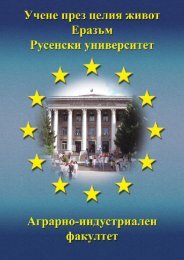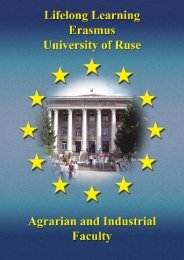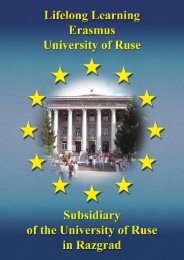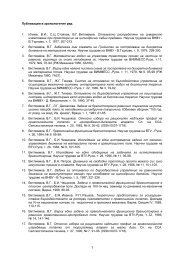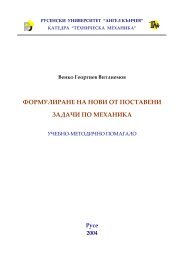Erasmus ECTS Information Package
Erasmus ECTS Information Package
Erasmus ECTS Information Package
You also want an ePaper? Increase the reach of your titles
YUMPU automatically turns print PDFs into web optimized ePapers that Google loves.
<strong>Erasmus</strong> <strong>ECTS</strong> <strong>Information</strong> <strong>Package</strong><br />
Faculty of EEEA<br />
3123 Optoelectronics and Optical Communications<br />
<strong>ECTS</strong> credits: 4<br />
Weekly classes: 2lec+0sem+0labs+2ps+1ca<br />
Form of assessment: continuous<br />
Type of exam: written<br />
Department involved:<br />
Department of Telecommunications<br />
Faculty of Electrical Engineering, Electronics and Automation<br />
Lecturers:<br />
Assoc. Prof. Tamara Grigorievna Pencheva, MSc, PhD, Dept. of Physics, tel.: 888 218,<br />
E-mail tgp@uni-ruse.bg<br />
Assistant Professor Berkant Gyoch, MSc, Dept. of Physics, tel.: 888 218,<br />
E-mail: b_gyoch@uni-ruse.bg<br />
Abstract:<br />
The course aims at familiarising the students with complex theoretical, methodological and apparatus problems in<br />
recent coherent and incoherent optoelectronics, at introducing the students to applications of optoelectronics<br />
devices and systems in communication engineering.<br />
The practical exercises aim at creating skills for experimental investigation of optoelectronic devices and solving of<br />
practical problems connected with their application in communication engineering.<br />
Course content:<br />
Basic properties and characteristics of optical radiation; incoherent optoelectronics; optical sources,<br />
photoreceivers; optrons; integrated optoelectronics; coherent optoelectronics: light amplification and generation,<br />
types of coherent light sources (lasers), comparison of their characteristics, laser emission control, coherent light<br />
propagation through the atmosphere and in optical waveguides; optical fibers and cables, the main application<br />
areas of optoelectronics and optical fiber systems and devices in industry. The course focuses on elemental<br />
composition and working principles of optoelectronic devices, their basic parameters and specific application<br />
areas.<br />
Teaching and assessment:<br />
Lectures give the main theoretical material, supported by some demonstrations of optoelectronic phenomena and<br />
processes. At the practical exercises the student works independently and investigates particular optoelectronic<br />
phenomena, optoelectronics and fiber-optics elements, devices and systems.<br />
The knowledge of the lecture material and issues discussed at the practical exercises is tested regularly in two<br />
tests. The final mark is formed according to a proposed system of credits.<br />
3118 Course Project on Radio Communication Techniques<br />
<strong>ECTS</strong> credits: 2<br />
Weekly classes: 0lec+0sem+0labs+0ps+3cp<br />
Assessment: defence<br />
Type of exam: oral<br />
Department involved:<br />
Department of Telecommunications<br />
Faculty of Electrical Engineering, Electronics and Automation<br />
Lecturers:<br />
Assoc. Prof. Mihail Petkov Jeliazov, MEng, PhD, Dept. of Telecommunications, tel.: 888 381,<br />
Е-mail: mjeliazov@mail.bg<br />
Abstract:<br />
The students expand their knowledge, gained from the Radio-communication Engineering and Radio-wave and<br />
Microwave Engineering courses. The students form abilities for independent decision-making on every<br />
engineering problem and designing of radio-communication devices.<br />
Course content:<br />
Topics discussed: Design of radio-receiving antennae systems, Markony type. Design of transmitters for the end<br />
radio-relay station. Design of receivers for the end radio-relay station. Design of active retranslators of heterodyne<br />
type with two independent SHF generators. Design of active retranslators of heterodyne type with one SHF<br />
generator and two medial frequencies. Design of active retranslator of heterodyne type with one SHF generator<br />
and one medial frequency.<br />
Teaching and assessment:<br />
At the beginning of the term an individual task is submitted to every student. During the practical exercises typical<br />
problems including elements from the students’ tasks are solved. Personal discussions with every student are<br />
carried out weekly where students have to present the intermediate results from their work on the design and get<br />
instructions on how to continue. The final project work has to be described in 15-20 pages. It includes the<br />
engineering design and calculations of all electrical devices and modules, and a functional and principal diagram<br />
of the system under design have to be provided as well. The project work is presented personally by each student<br />
during the last week of the term.<br />
201



